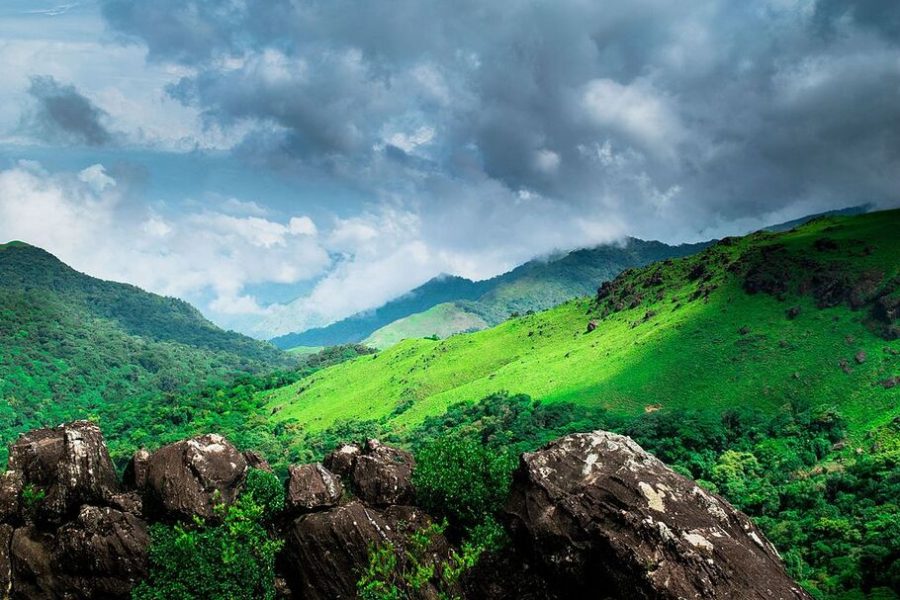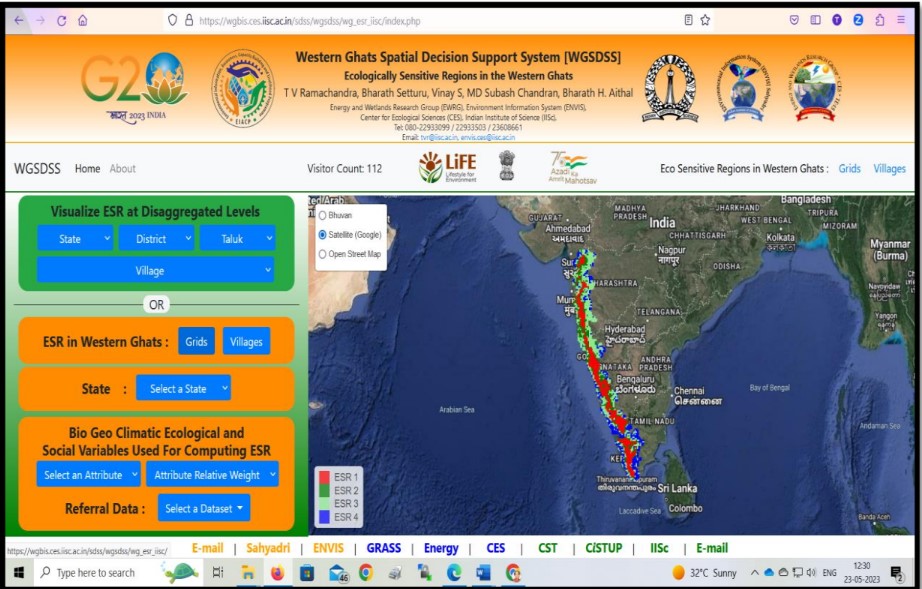
Is your area 'ecologically sensitive'? Find out from a new app by IISc

If you are a resident of a village or taluk in the Western Ghats region (in Tamil Nadu, Kerala, Karnataka, Goa Maharashtra or Gujarat), you can find out the ecological sensitivity of the area you live in at your fingertips. And armed with this key knowledge, you can now organise your own conservation efforts in your residential area, if required.
Yes. All you have to do is click on your area and know about its ecological sensitivity from a newly developed, innovative application called the ‘Western Ghats Spatial Decision Support System’ (WGSDSS). What is unique about this app is that even a layman can access the information and learn how ‘ecologically sensitive’ his village or taluk is and find solutions to improve it if it is damaged.
This application has been developed by Dr TV Ramachandra, scientific officer, Centre for Ecological Sciences, Indian Institute of Science, Bangalore, under the IISc EIACP [RP] Environmental Information Awareness Capacity Building and Livelihood programme. He has used all his experience of 25 years and all the data he has collected during his research in the Western Ghats area on this project.
His team included researchers Bharath Setturu, Vinay S, M D Subash Chandran, Abhishek Baghel, and Bharath H Aithal.

Six states covered by app
The six states attached to the Western Ghats area include Karnataka, Kerala, Tamil Nadu, Maharashtra, Gujarat and Goa, and all the districts, taluks and villages of these states can be found on this application. One can check the ecological sensitivity of any these areas from the app.
The details of this app were submitted to the Karnataka Chief Minister Siddaramaiah recently.
Also watch: Excessive stone quarrying rampant in Western Ghats
How the app helps
This app primarily will enhance governance transparency while meeting the needs of society and help to manage the ecologically and hydrologically vital Western Ghats ranges. Using this application, we can find out the ecological sensitivity of every village, taluk, district and state and entire Western Ghat region and help to understand the situation.
The government or policy makers can make decision after knowing the facts on ecological sensitivity and take conservation steps. It will be helpful for the Biodiversity Management Committees in the village panchayat level to actively participate in saving the environment by knowing the ecological sensitivity.
In an interview with The Federal, Dr TV Ramachandra told The Federal, “According to the Biodiversity Act 2002, BMCs (Biodiversity Management Committees) should be set up in every panchayat. The newly developed application will empower BMCs. They will know about the Ecological Sensitivity of their particular region and also what kind of activities can be allowed in that area.”
Even any layman can access information on the ecological sensitivity of his village and he can find solutions to improve if the ESR (Ecological Sensitivity Region) is damaged. The government departments, village panchayats, taluk panchayats, district-level officials, MLAs, and ministers can browse the ESR rate of their area and find out solutions if any problems persist. Even the public can ask their representatives to work on it.
“The ecological sensitivity of districts and villages of the Western Ghats is available on the application and anyone can check it. We have also provided the variables used for identifying the ESR level of a particular place,” added Dr Ramachandra.
Committee reports
The Madhava Gadgil committee report was more environment friendly and recommended strict solutions to conserve the ecosystem. It asked for a complete eco-sensitive cover for the Western Ghats and was against dams, completely prohibited sand mining and quarrying or timber business.
While the Kasturirangan report toned down the Gadgil recommendations and did not suggest that the entire areas of the Western Ghats to be brought under Ecological Sensitive Areas. Though, they also asked for a complete ban on mining, quarrying and sand mining in ESAs, it made several pro-farmer recommendations, including the exclusion of inhabited regions and plantations from the purview of ESAs.
“There are mafias, and businesses who pressurise the government not to implement any report and nurture the ecological sensitive areas. But, we haven’t taken into account such issues and developed the ESRs based on the biological, geological, psychological, hydrological and social parameters of those areas,” Dr Ramachandra said.
Psychological parameters would include the characteristics of the village population, their living standards, source of their living etc., while the hydrological parameter would be the detailed study of the soil, water flow, groundwater level, how the ground water or rain water is absorbed by soil etc.
Also read: Bommai opposes declaring Western Ghats as eco sensitive zone
ESR levels
According to Dr Ramchandra, an ecologically sensitive region (ESR) is a bio-climatic unit (as demarcated by entire landscape) wherein human impacts may cause irreversible changes in the structure of biological communities like flora and fauna) and their natural habitats.
So, the application will help the people to locate in which zone they reside. The ESR levels have been developed after a lot of research and studies, he pointed out.
“If an area falls under ESR-1, then the area has a higher conversation value and ESR-2 is as good as ESR-1 and both shall not be disturbed. ESR-3 is an area that be ecologically restored by bringing back life into that area and ESR-4 is where development and activities can happen,” he said.
“If it is ESR 1 or 2, ecological sensitivity can be achieved without displacing the residents of that particular area. Some officials and timber mafia are spreading rumours that residents will be chased out of such sensitive areas. This is being done to steal the timber and to invite projects in that area. We should not allow such things,’’ he said.
How improving ESR levels helps
Another purpose of creating these ecologically sensitive zones or ESRs is to help the people who live there get water and a good life. “Our studies showed the ESRs have plenty of water for the whole year and the areas, which lost sensitivity, get water for 4 or 6 months. Our research has found that wherever they have plenty of water, they will get ₹1.54 lakh revenue per acre per year by planting multiple crops. In some villages, where water is scarce, they will get ₹35,000 per acre per year and opt to plant just a the single crop in the region,” he said.
“Another interesting thing is that in ESR-1 and ESR-2, a lot of pollinators like butterflies and bees are more active and help in more pollination and helps in getting more yield. In such places, 12 to 16 quintal crop yield crops is seen, whereas it is 6 to 8 quintal rice per acre, where ESR is poor,” he said.
“If we improve ESR levels, the income will also be doubled,” he added.
Kodagu and other such districts are facing floods and landslides and other issues because the ecological sensitivity is less. “We have to conserve such areas and then there will be no such issues,” he pointed out.
About WGSDSS
Western Ghats Spatial Decision Support System (WGSDSS) has been designed by IISc as part of their ongoing ecological research in the Western Ghats. The app has been developed with the help of material from the various research and studies in the Western Ghat region by IISc. Technologically, the app is developed by the open source web technologies.


